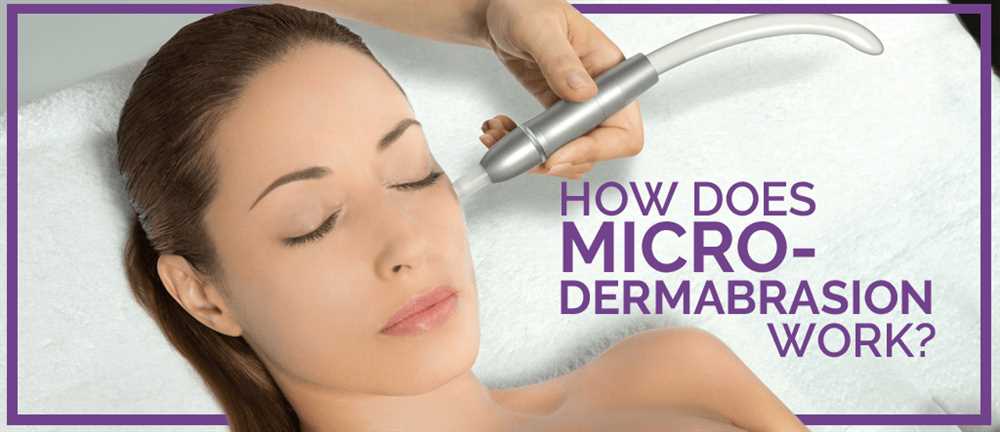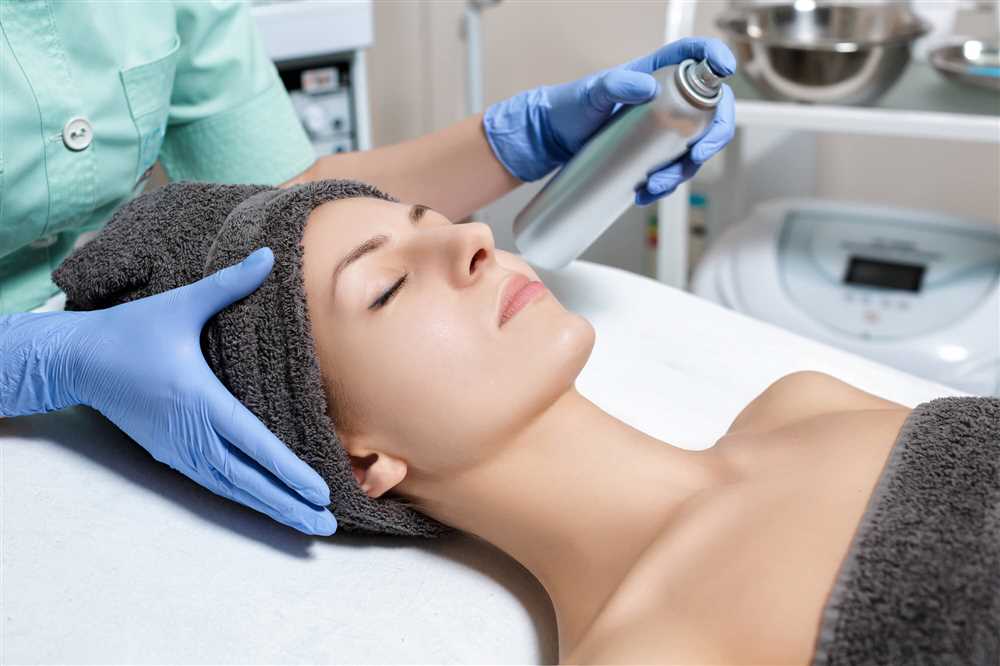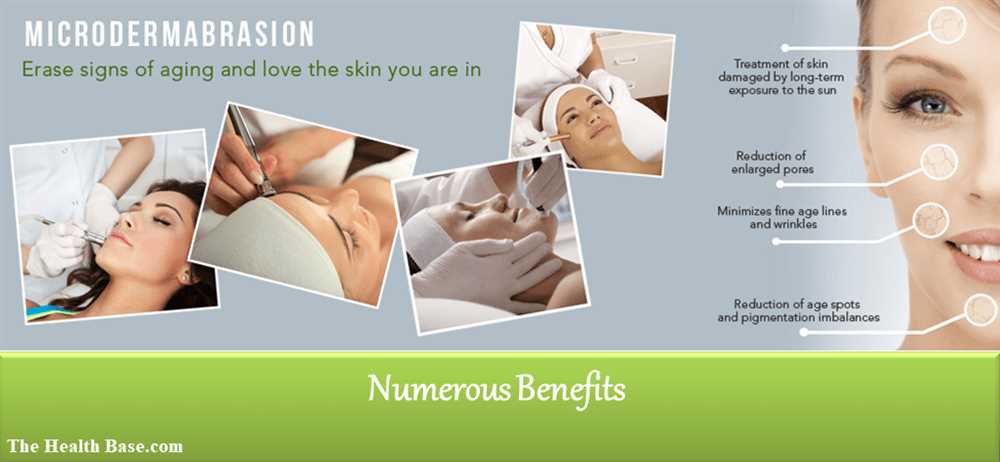
If you are considering microdermabrasion as a skincare treatment, it is important to determine the appropriate level of intensity for your skin. Microdermabrasion is a non-invasive procedure that uses tiny crystals or a diamond-tipped wand to exfoliate and remove the outermost layer of dead skin cells. It can improve skin texture, reduce fine lines and wrinkles, and enhance the overall appearance of your skin.
Before undergoing microdermabrasion, it is essential to test the level of intensity on a small area of your skin. This will help you determine if the treatment is suitable for your skin type and sensitivity. The intensity of microdermabrasion can be adjusted based on the thickness of the crystals or the speed and pressure of the diamond-tipped wand. By carefully testing the treatment on a small patch of skin, you can ensure that it does not cause any adverse reactions or discomfort.
During the test, pay close attention to any sensations or reactions on your skin. It is normal to experience a mild tingling or scratching sensation during microdermabrasion, but it should not be painful. If you feel any sharp or intense pain, stop the test immediately and consult with a skincare professional. Additionally, observe your skin for any signs of irritation, redness, or swelling after the test. These could be indications that the intensity level is too high for your skin and may cause unwanted side effects.
Remember, everyone’s skin is different, and what works for one person may not work for another. By testing the microdermabrasion level on a small area of your skin, you can ensure that the treatment is safe and effective for your specific needs. Consult with a skincare professional or dermatologist to determine the most appropriate level of intensity and to discuss any concerns or questions you may have regarding microdermabrasion.
Why Is It Important to Test the Microdermabrasion Level?
Microdermabrasion is a popular skin treatment that involves exfoliating the outermost layer of skin to reveal a smoother, more youthful complexion. However, the level of microdermabrasion used during the treatment can greatly affect the results and potential side effects. That is why it is crucial to test the microdermabrasion level before proceeding.
Testing the microdermabrasion level allows the esthetician or dermatologist to determine the appropriate intensity for each individual’s skin type and concerns. Every person’s skin is unique, and what may be an acceptable level of exfoliation for one person may be too harsh for another. By performing a test, professionals can ensure that the treatment is tailored to the specific needs and tolerance of the client.
During the test, the professional will typically apply the microdermabrasion device on a small area of the skin, such as the forearm or neck, at different intensity levels. They will carefully observe the skin’s reaction, looking for signs of redness, irritation, or discomfort. Based on these observations, they can then adjust the treatment level accordingly.
Testing the microdermabrasion level is particularly important for individuals with sensitive skin or certain skin conditions, such as rosacea or eczema. These individuals may have a lower tolerance for intense exfoliation, and using the wrong level of microdermabrasion can potentially worsen their condition or cause other adverse effects. By performing a test, professionals can ensure that the treatment is safe and suitable for these individuals.
In conclusion, testing the microdermabrasion level is a vital step in ensuring the effectiveness and safety of the treatment. By tailoring the intensity to each individual’s needs and observing their skin’s reaction, professionals can provide optimal results while minimizing the risk of complications. So, if you are considering microdermabrasion, make sure to find a qualified professional who values proper testing and customization of the treatment.
Understanding the Benefits of Microdermabrasion

Microdermabrasion is a non-invasive skincare procedure that helps rejuvenate the skin by exfoliating the outermost layer, revealing a smoother and more youthful complexion. This treatment is often performed at skincare clinics or by dermatologists using a device that sprays tiny crystals onto the skin’s surface and then vacuums them away. It is a popular choice for individuals looking to improve the appearance of their skin without undergoing more aggressive procedures, such as chemical peels or laser treatments.
One of the primary benefits of microdermabrasion is its ability to reduce the appearance of fine lines and wrinkles. By removing the outer layer of dead skin cells, microdermabrasion stimulates collagen production, which helps plump up the skin and minimize the appearance of these common signs of aging. Additionally, microdermabrasion can help improve the texture and tone of the skin, making it look smoother and more even.
Another advantage of microdermabrasion is its ability to treat acne and acne scars. By exfoliating the skin and unclogging pores, this procedure can help reduce the frequency and severity of breakouts. It can also improve the appearance of acne scars by stimulating cell turnover and promoting the growth of new, healthier skin cells. For individuals with acne-prone skin, microdermabrasion can be a valuable addition to their skincare routine.
In addition to its anti-aging and acne-fighting benefits, microdermabrasion can also help improve the effectiveness of skincare products. By removing the outer layer of dead skin cells, microdermabrasion allows serums, moisturizers, and other skincare products to penetrate deeper into the skin, maximizing their benefits. This can result in improved hydration, increased collagen production, and a more radiant complexion.
The Importance of Choosing the Right Level
When it comes to microdermabrasion, choosing the right level is crucial for achieving desired results. Microdermabrasion is a skincare treatment that uses a handheld device to exfoliate the outer layer of the skin, revealing smoother and more radiant skin underneath. The device usually has adjustable settings for different levels of exfoliation. It is important to test and select the appropriate level based on personal preferences and skin type.
Targeting individual needs: Every person has unique skincare needs, and microdermabrasion can be tailored to address specific concerns. Whether it is reducing the appearance of fine lines, wrinkles, acne scars, or pigmentation issues, selecting the right level of exfoliation is crucial. By testing different levels and observing the skin’s response, one can determine the optimal setting that provides the desired benefits without causing any adverse effects.
Considering skin sensitivity: Skin sensitivity varies from person to person, and it is important to choose a level of exfoliation that the skin can tolerate. Testing the different levels allows individuals to assess how their skin reacts and adjust accordingly. Those with sensitive skin may start with a lower setting and gradually increase as their skin becomes accustomed to the treatment.
Preventing skin damage: Opting for the correct level of microdermabrasion is essential for preventing skin damage. Testing the microdermabrasion level on a small area of the skin helps to determine if the chosen setting is too aggressive. Using a level that is too high can cause redness, irritation, or even abrasions. It is important to start with a lower level and gradually increase if necessary to avoid any potential harm to the skin.
Improving treatment efficacy: Selecting the right level of microdermabrasion ensures that the treatment is effective in achieving the desired results. Testing different levels allows individuals to find the ideal setting that successfully exfoliates the skin without being too harsh or too gentle. This way, the treatment can effectively remove dead skin cells, improve skin texture, and stimulate collagen production, leading to a more youthful and rejuvenated appearance.
How to Determine the Suitable Microdermabrasion Level
Microdermabrasion is a popular skincare treatment that exfoliates and rejuvenates the skin. One important factor to consider when undergoing microdermabrasion is the level of intensity or abrasiveness of the treatment. Determining the suitable microdermabrasion level is crucial for achieving the desired results without causing any harm to the skin. Here are some tips to help you determine the right level of microdermabrasion for your skin.
1. Consult a Skincare Professional
Before deciding on the microdermabrasion level, it is recommended to consult a skincare professional or dermatologist. They can assess your skin type and condition and provide expert advice on the suitable level of treatment. A professional can also address any concerns or specific needs you may have, ensuring a safe and effective microdermabrasion experience.
2. Consider Your Skin Sensitivity
Take into account your skin’s sensitivity when determining the appropriate microdermabrasion level. If you have sensitive skin, it is advisable to start with a lower intensity level and gradually increase it over time. This helps minimize the risk of any adverse reactions or discomfort. On the other hand, if you have resilient or tolerant skin, a higher intensity level may be suitable to achieve more noticeable results.
3. Assess Your Skincare Goals
Clearly define your skincare goals before selecting a microdermabrasion level. Are you aiming to reduce fine lines and wrinkles, improve skin texture, treat acne scars, or simply achieve a brighter complexion? Different levels of intensity can target specific skin concerns more effectively. Discuss your goals with a skincare professional to determine the most suitable microdermabrasion level for your desired outcomes.
4. Start with a Conservative Approach

If you are new to microdermabrasion or unsure about the suitable level, it is recommended to start with a conservative approach. Begin with a lower intensity level and monitor how your skin responds. Gradually increase the level if your skin tolerates the treatment well and you desire more significant results. It’s important to listen to your skin and adjust accordingly to avoid any potential irritation or damage.
By following these guidelines and seeking professional advice, you can determine the suitable microdermabrasion level that aligns with your skin’s needs and goals. Achieve a refreshed and revitalized complexion with the right intensity level of microdermabrasion treatment.
Consulting with a Dermatologist
When it comes to determining the appropriate level of microdermabrasion, seeking the advice of a dermatologist is highly recommended. Dermatologists are medical experts who specialize in the diagnosis, treatment, and prevention of skin conditions. They have extensive knowledge and experience in assessing individual skin types and conditions, making them the best professional to consult for personalized treatment recommendations.
During a consultation with a dermatologist, they will carefully evaluate your skin and assess its specific needs. They will consider factors such as skin type, sensitivity, and any existing skin conditions or concerns. Additionally, they may inquire about your skincare routine, lifestyle habits, and medical history, as these factors can influence the appropriate level of microdermabrasion for your skin.
Once the dermatologist has thoroughly assessed your skin, they will be able to recommend the optimal level of microdermabrasion for you. They will take into account your skin’s tolerance and sensitivity, as well as the desired results you are hoping to achieve. There are different levels of microdermabrasion available, ranging from gentle to more intense treatments, and a dermatologist will guide you in choosing the level that will provide the best outcome for your skin.
- It is important to emphasize that consulting with a dermatologist before undergoing any skin treatment, including microdermabrasion, is crucial for your safety and optimal results.
- A dermatologist’s expertise will ensure that the treatment is tailored to your individual needs and helps address any specific concerns you may have.
- They can also provide guidance on post-treatment skincare products and routines to maximize the benefits of microdermabrasion.
Considering Skin Sensitivity and Type
Skin sensitivity and type are important factors to consider when testing the microdermabrasion level. Different individuals have different skin sensitivities and types, which can greatly affect the outcome of the treatment. It is crucial to understand the specific needs and limitations of each skin type in order to ensure safe and effective results.
Skin sensitivity is a measure of how easily the skin reacts to various stimuli. Some people have sensitive skin that is prone to irritation, redness, and allergic reactions, while others have less sensitive skin that can tolerate more aggressive treatments. When testing the microdermabrasion level, it is important to start with a low setting and gradually increase it until the desired effect is achieved without causing any negative skin reactions.
Skin type refers to the natural characteristics of the skin, such as oiliness, dryness, and elasticity. There are generally four main skin types: normal, dry, oily, and combination. Each skin type has its own specific needs and reactions to different treatments. For example, individuals with dry or sensitive skin may require a lower microdermabrasion level to prevent excessive dryness or irritation, while those with oily or acne-prone skin may benefit from a higher level to help exfoliate and unclog pores.
- Normal skin is well-balanced and not overly sensitive or dry. Individuals with normal skin can generally tolerate a wide range of microdermabrasion levels, but it is still important to start with a lower setting and gradually increase it to assess the skin’s response.
- Dry skin lacks moisture and can be prone to flakiness and tightness. Individuals with dry skin should use a less aggressive microdermabrasion level to avoid further drying out the skin and causing irritation. It is also important to moisturize the skin properly before and after the treatment.
- Oily skin has excess sebum production, leading to a shiny appearance and clogged pores. Individuals with oily skin may benefit from a higher microdermabrasion level to exfoliate and remove excess oil and unclog pores. However, it is important to monitor the skin closely and adjust the level as needed to prevent overstimulation.
- Combination skin is a mix of different skin types, with some areas being oily and others being dry. When testing the microdermabrasion level on combination skin, it is important to consider the specific needs of each area and adjust the level accordingly. A lower setting may be suitable for dry areas, while a higher level may be needed for oily areas.
In conclusion, when testing the microdermabrasion level, it is crucial to take into account the skin sensitivity and type of each individual. By considering these factors and making necessary adjustments, it is possible to achieve safe and effective results that address specific skin concerns.